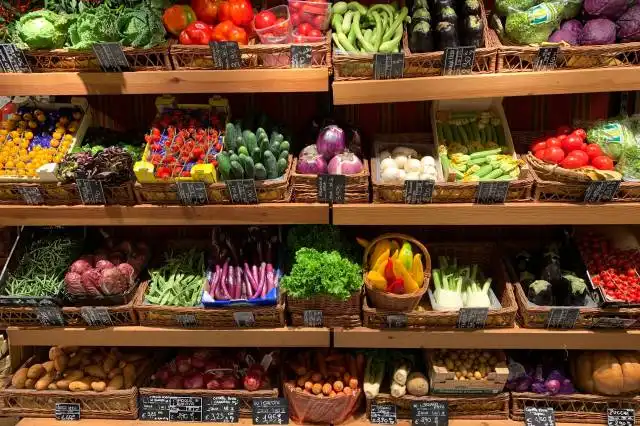Start a Mexican Grocery Store
Unwrapping the Flavorful Burrito of a Mexican Grocery Store Venture
| Updated


MEXICAN GROCERY STORE
Embarking on the journey of setting up your very own Mexican Grocery Store is like fixing yourself a flavorful burrito, but instead of wrapping meat and beans, you'll be wrapping up culture, convenience, and commerce in one! This type of business caters to supplying the community with a variety of diverse products straight from Mexico such as food items, beverages, spices, and even some authentic Mexican homewares. So get ready to turn up the Mariachi music, stock spicy salsa and creamy guacamole onto your shelves, and serve your local and "foodie" customers with a taste of Mexico, right on their doorsteps!
Jump to Business Plan
RELATED BUSINESS IDEAS
Browse ALL Retail & Shopping Business Ideas
Discover Your Perfect Domain
Unlock the door to your online success with our hand-picked selection of premium domain names. Whether you're starting a new venture or rebranding an existing one, the right domain can set the tone for your digital presence. Browse through our curated list, each with its unique potential to enhance your brand's visibility and credibility.
MEXICAN GROCERY STORE MINI BUSINESS PLAN
This a quick reality check to help you identify the strengths and weaknesses of your business concept before you dive in.
Business Analysis: Mexican Grocery Store
Expected Percent Margin:
- Gross Margin: 25-30% (Industry standard for grocery stores)
- Net Profit Margin: ~1-3% (Low margin, high volume business)
Earnings Expectations:
- Daily Earnings: ~$1,000 - $5,000 depending on the location and size of the store.
- Weekly Earnings: ~$7,000 - $35,000.
- Monthly Earnings: ~$30,000 - $150,000.
- Annual Earnings: ~$360,000 - $1,800,000.
Actions to Hit Those Numbers:
Inventory Management:
- Initial Investment: This can range from $50,000 - $200,000 or more based on the size of the store and variety of items you want to stock.
- Supplier Network: Establish a network of both local and international suppliers to offer a variety of Mexican goods and produce.
Marketing and Customer Acquisition:
- Community Involvement: Participate in local events to raise brand awareness and promote your store.
- Promotions: Regular discounts and loyalty programs for regular customers.
Sales and Customer Experience:
- Staffing: Ensure you have enough staff to manage customers especially during peak hours.
- Bilingual Staff: Since it's a Mexican grocery store, hire Spanish-speaking staff to assist customers who speak Spanish.
Cost Control:
- Rent and Overheads: Rent should ideally not exceed 2-5% of expected sales. Overheads including utilities should be around 10% of sales.
- Loss Prevention: Implement systems to minimize shoplifting and wastage.
Business Operations:
- Open Hours: Open 7 days a week, typically 10-12 hours a day to cater to working customers.
- Transaction Volume: Grocery stores typically see 100's of transactions a day, with higher volume on weekends. Aim to maintain a good average transaction value.
Remember, this is a general projection. Actual numbers can vary based on several factors including location, competition, quality of service, etc.
NOT WHAT YOU HAD IN MIND? Here are more ideas



Browse ALL Retail & Shopping Business Ideas
Grab Your Business Website Name
Before you get caught up in the whirlwind of setting up your business, invest in a domain name. It's a small but significant step that lays the foundation for your brand and makes it easier for customers to find and trust you. Just like you wouldn't build a house without securing the land first, don't build a business without securing your domain name.
"Why? Can't that wait?" Here's why it shouldn't
Step 1: Determine if the Business is a Right Endeavor
Breakdown of Startup Expenses
Before starting a Mexican grocery store, it is important to understand the startup costs associated with the business. This includes the cost of the building or space, the cost of any necessary permits or licenses, the cost of any equipment or fixtures, and the cost of any inventory. Additionally, it is important to consider the cost of any marketing and advertising materials, as well as the cost of any employees. It is important to have a thorough understanding of the startup costs associated with the business in order to determine if the business is a feasible endeavor.
Breakdown of Ongoing Expenses
Once the business is up and running, there are ongoing expenses that must be taken into account. This includes the cost of any inventory that needs to be replenished, the cost of any employees, the cost of any marketing and advertising materials, and the cost of any necessary permits or licenses. Additionally, it is important to consider the cost of utilities, such as electricity and water, as well as the cost of any maintenance or repairs. It is important to have a thorough understanding of the ongoing expenses associated with the business in order to determine if the business is a feasible endeavor.
Examples of Ways to Make Money
There are a variety of ways to make money with a Mexican grocery store. This includes selling a variety of Mexican food items, such as tacos, burritos, and enchiladas. Additionally, the store can offer a variety of Mexican spices, sauces, and seasonings. The store can also offer a variety of Mexican-themed decorations, such as piñatas and sombreros. Additionally, the store can offer a variety of Mexican-themed apparel, such as t-shirts and hats. It is important to have a thorough understanding of the ways to make money with the business in order to determine if the business is a feasible endeavor.
Step 2: Name the Business
When it comes to naming your Mexican grocery store, you want to make sure that it is something that is memorable and easy to pronounce. You also want to make sure that it reflects the culture and values of your store. Consider using words that are associated with Mexican culture, such as Azteca, Tequila, or Fiesta. Additionally, you may want to consider using a combination of Spanish and English words, or even a play on words. For example, you could use the phrase “Taco ‘Bout Fresh” or “Taco ‘Bout Grocery.” You should also make sure that the name is easy to spell and that it is not already taken by another business. Once you have chosen a name, you should check with your local government to make sure that it is available to use. Additionally, you should also check with the US Patent and Trademark Office to make sure that the name is not already trademarked.
Once you have chosen a name, you should also consider registering it with your local government. This will help to protect your business name from being used by another business. Additionally, registering your business name will also help to ensure that you are the only one who can use it. Furthermore, registering your business name will also help to establish your business as a legitimate entity. This will make it easier for you to open a business bank account, obtain a business license, and apply for any necessary permits.
In addition to registering your business name, you should also consider creating a logo for your business. This will help to create a visual representation of your business and will help to make your business more recognizable. When creating your logo, you should consider using colors and symbols that are associated with Mexican culture. Additionally, you should also consider using a font that is easy to read and that reflects the values of your business.
Finally, once you have chosen a name and created a logo, you should consider creating a website for your business. This will help to make your business more visible and will help to attract potential customers. Additionally, having a website will also make it easier for customers to find information about your business, such as your hours of operation and the products that you offer. Furthermore, having a website will also make it easier for customers to contact you and place orders.
Step 3: Research the Market
Analyzing the competition is an important part of starting a Mexican grocery store. It is important to research the local competition and determine what they are offering and how they are doing it. Are they offering a wide variety of products? Are they providing good customer service? Are they meeting the needs of the local community? This research will help you determine what you need to do to stand out from the competition.
Assessing the demand is also important when starting a Mexican grocery store. You need to determine if there is a need for a Mexican grocery store in the area. Are there enough customers to make the store profitable? Are there enough customers to support the store long-term? You can research the local population to determine the demand for Mexican food and products. You can also look at the local demographics to determine if there is a large enough population of Mexican people in the area.
Once you have analyzed the competition and assessed the demand, you can make an informed decision about whether or not to move forward with the business. You can also use this research to inform your business plan and determine the best way to make your store stand out from the competition.
Step 4: Create a Business Plan
Outline the Business Goals
Before creating a business plan, it is important to first outline the goals of the business. This should include the type of products you plan to offer, the target market, and the overall mission of the business. Additionally, you should also consider the long-term goals of the business, such as the number of stores you plan to open and the number of employees you plan to hire.
Establish a Budget
After outlining the goals of the business, it is important to establish a budget. This should include both the startup costs and the ongoing costs associated with running the business. It is important to be realistic when creating a budget, as it will help you to determine the feasibility of the business. Additionally, it is important to consider the potential income of the business, as well as the potential risks associated with the business. This will help you to create a budget that is both realistic and achievable.
Step 5: Secure Financing
Options for Financing
When starting a Mexican grocery store, it is important to consider the various financing options available. Some of the most common financing options include traditional bank loans, small business loans, grants, and crowdfunding. Additionally, many entrepreneurs choose to use their own personal savings or investments from family and friends. It is important to research each option and determine which one is the best fit for the business.
Tips for Securing Financing
When seeking financing for a Mexican grocery store, it is important to have a solid business plan that outlines the goals of the business and how the funds will be used. Additionally, it is important to have a clear understanding of the financials of the business, including the startup costs and ongoing expenses. It is also important to have a good credit score and to be prepared to provide collateral if necessary. Finally, it is important to shop around and compare different financing options to ensure the best rates and terms.
Step 6: Find a Location
Considerations for Location
When looking for a location for your Mexican grocery store, there are several factors to consider. First, you should think about the size of the store. You want to make sure that you have enough space to accommodate all of the products you plan to carry. Additionally, you should consider the location of the store. You want to make sure that it is in a convenient location for customers to access. You should also consider the cost of the location. Depending on the area, the cost of rent or purchasing a building can vary greatly.
Tips for Finding a Location
When searching for a location for your Mexican grocery store, there are several tips to keep in mind. First, you should look for a location that is easily accessible to customers. This means that it should be close to public transportation, parking, and other businesses. Additionally, you should look for a location that is in a safe area. You want to make sure that customers feel comfortable coming to your store. Finally, you should look for a location that has a good amount of foot traffic. This will help to ensure that customers are able to find your store and that you have a steady stream of customers.
Step 7: Obtain Licenses and Permits
Types of Licenses and Permits
Before opening a Mexican grocery store, it is important to understand the types of licenses and permits that are required. Depending on the location, a business license, food service license, and health permit may be required. Additionally, a liquor license may be needed if the store plans to sell alcoholic beverages. It is important to check with local authorities to determine the exact licenses and permits needed.
Tips for Obtaining Licenses and Permits
Once the types of licenses and permits are determined, the next step is to obtain them. The best way to do this is to contact the local government office that handles business licenses and permits. They will be able to provide information on the application process, fees, and any other requirements. Additionally, they may be able to provide guidance on how to complete the application process. It is also important to note that the process may take several weeks or even months, so it is important to plan accordingly.
Step 8: Stock the Store
Tips for Choosing Inventory
When stocking the store, it is important to choose inventory that will appeal to the target customer base. Consider the local demographics and what type of products they are likely to purchase. Research the competition to see what types of items they carry and what is popular in the area. Consider stocking items that are unique and not widely available in the area. Additionally, it is important to stock items that have a high profit margin.
Tips for Managing Inventory
In order to effectively manage inventory, it is important to track the items that are selling and restock them as needed. Additionally, it is important to keep track of the expiration dates of items, as well as the cost of the items. Utilizing a software program or an inventory tracking system can help to keep track of the items in the store. Additionally, it is important to keep the shelves organized and to rotate the inventory to ensure that the items that have been in the store the longest are sold first. Finally, it is important to keep track of the inventory levels to ensure that the store is not overstocked.
Step 9: Promote the Store
Promoting the store is essential to its success. There are a variety of ways to promote a Mexican grocery store. Advertising in local newspapers, radio, and television can be effective. Social media can also be used to reach potential customers. Creating a website and using search engine optimization (SEO) techniques can help drive traffic to the store. Additionally, offering discounts or promotions can be a great way to attract customers.
Considerations for Promoting the Store
When promoting the store, it is important to consider the target audience. Knowing who the store is trying to reach can help determine the best methods of promotion. Additionally, it is important to consider the budget for promotion. Advertising can be expensive, so it is important to find the most cost-effective methods of promotion. Finally, it is important to track the results of any promotional efforts to determine which methods are most effective.
EXPLORE MORE CATEGORIES
Browse ALL Business Idea Categories
TAKE THE NEXT STEPS










